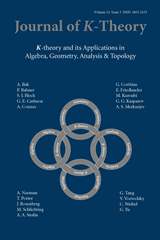No CrossRef data available.
Article contents
Algebraic cycles satisfying the Maurer-Cartan equation and the unipotent fundamental group of curves
Published online by Cambridge University Press: 04 April 2013
Abstract
We address the question of lifting the étale unipotent fundamental group of curves to the level of algebraic cycles and show that a sequence of algebraic cycles whose sum satisfies the Maurer-Cartan equation would do the job. For any elliptic curve with the origin removed and the curve  , we construct such a sequence of algebraic cycles whose image under the cycle map gives rise to the étale unipotent fundamental group of the curve.
, we construct such a sequence of algebraic cycles whose image under the cycle map gives rise to the étale unipotent fundamental group of the curve.
Keywords
- Type
- Research Article
- Information
- Copyright
- Copyright © ISOPP 2013




